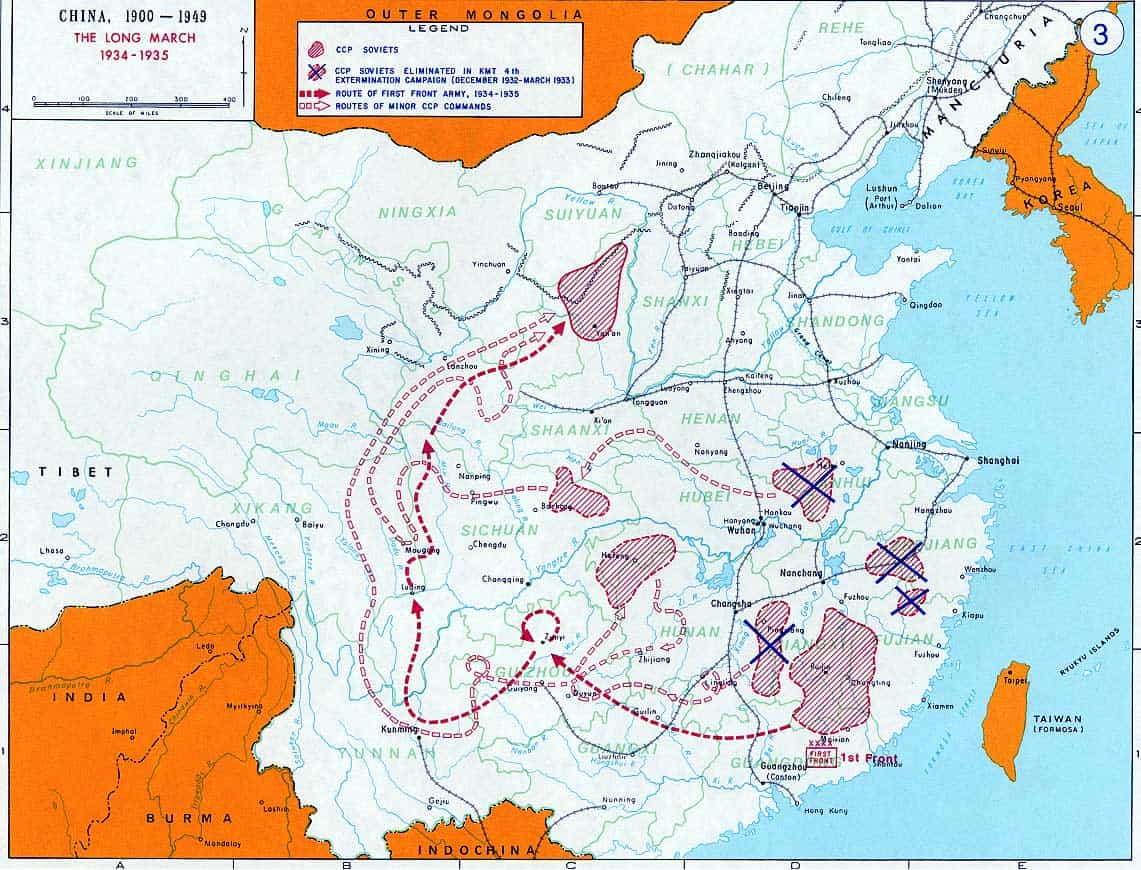Big Red Car here. I’m getting a bit worried about The Boss. It’s snowing like nuts in Steamboat Springs and the first retail marijuana store has apparently opened in the ‘Boat.
I hope he doesn’t get mowed down by a snowboarder. A stoned snowboarder.
The Long March as evolving startup analogy
In Chinese history, Mao’s Long March was the formative struggle that propelled his rise to power. Mao was the leader of the retreat from Jiangxi to Shaanxi. [Hell, Big Red Car, folks already knew that stuff. Stop showing off. Sheesh, Big Red Car.]
The total distance covered was over 6,000 miles, took 370 days (took a total of almost exactly two years but only 370 days of actual movement) and only 10% of those who left Jiangxi made it to Shaanxi. It was a journey through the roughest terrain in China.
The Red Army was surrounded in the South by Generalissimo Chiang Kai-shek and the decision to retreat to the northwest was a military decision. If the Red Army stayed in the South, they would likely be annihilated.
The Red Army fled 6,000 miles and arrived at a location which allowed them to avoid further combat and rebuild their combat power. They had to fight their way to get there. Their losses were monumental. In the end, they won.
Those who made the journey were forever marked as men of destiny and rose to positions of power with the Red Chinese Communist Party. It is interesting to note that Mao Zedong had fallen out of favor and power before the Long March and his leadership on the Long March was the key to his rise and return to power.
In many ways this like a startup in which the company evolves, lives through very difficult times and rearranges the deck chairs as to its power structure re-seating those who performed well at the head of the table. The evolving startup.
The evolving company
Every startup evolves in rather dramatic ways. It is difficult to believe this but many startups hit a wall or an inflection point and undertake a meaningful pivot in their Vision, Mission, Strategy. It just happens. Some would argue it is the norm rather than the exception.
The challenge often becomes — can the leadership talent that birthed the company grow it into its adolescence and adulthood? In many instances, the answer is a resounding NO.
Even when leadership is adequate to the task, it may be necessary to change the leadership/management to operate effectively as the company grows.
This shows up in both the original founders and the founding cadre of talent.
The evolving talent
The talent to get a startup out of the cradle is often not the same talent required to grow the business. It is rarely the talent to scale the business.
Most organizations grow in a crawl, walk, run fashion — but one day you will have to both run and sprint. Not everyone can run and few can sprint.
Sometimes the original founding cadre of talent — your first professional hires — are competent for the crawl, walk phases but the run phase is not their cup of tea.
A prudent CEO [and a Board of Directors] has to constantly test for this phenomenon.
“Is my original team the right team for where we are today?”
This ultimately devolves to a microscopic focus which says:
“Hey, is my marketing guy good enough for the company as it exists today? Is he the right guy to take us to the next level?”
Make no mistake, this is perfectly normal. The pitching in the Show is a lot faster than in single A. Know it and ponder the implications. You are going to have to replace some folks just because they are not the “best” for the company as it exists today.
How does that make you feel? It makes a CEO feel like crap. “Hey, these are my guys, right? I hired these guys. Was I wrong?”
This is one of the toughest dilemmas for a CEO to deal with. But it has to be done a couple of times a year. Take out the organization chart and evaluate the talent. Use your performance appraisal system to bubble up the warning signs. Deal with it. Feeling bad about throwing some of the founding cadre overboard is perfectly normal. Sorry.
The evolving founder partnership
Many companies are created by a band of brothers whose complementary skills are the special sauce that makes it work together. It is a beautiful thing to behold. It works fine. Initially.
In these instances, there is almost always a sense of equality and partnership and camraderie. Everybody gets 33.33% of the business and things are great.
Not so fast, brilliant founders.
While initially leadership, management, technology, marketing, finance, operations skills may all look to be of equal value that is not true as the company grows.
The first thing becomes apparent is that you cannot run a growing enterprise by a committee and that the emergence of a single strong leader — the CEO — is of paramount importance. This is often just below the surface because leadership talent is not an equal distribution in the DNA of the founders. Sometimes Mother Nature has already figured it out and the founders have only to discover Mother Nature’s handiwork to get it right and then into practice.
Somebody has to be the boss and the sooner the founding partners sort this out the better. [One common theme regarding this subject is that speed is the best antidote on many of these issues pertaining to evolution. Allowing these issues to fester is always a bad thing and only makes the transaction cost more dear.]
The evolving CEO
The CEO understands the seriousness of these evolution issues because the Board is looking at him with the same measured calculus.
“Hey, can this current CEO get us to the pay window? Is this our guy?”
Hey, CEO, you do know that only about 10-20% of founders are still running the show come pay window time, right? You are very likely to be replaced yourself. Know this.
WTF, Big Red Car, WTF is a CEO supposed to do?
The CEO has to evaluate the organization and its status — crawl, walk, run — and whether he has the right team in place for both the current state of affairs but also the company’s requirements out 12-18 months. This is the strategic view of things. The 30,000′ view of things.
Whip out the organization chart — dollar weighted, please — and see where you are going to have to make individual changes. Identify them at least 6 months before your shorts spontaneously combust. This is the tactical view of things. The boots on the ground view of things.
Hire a head hunter and start identifying candidates. This can take a long time if the market is strong for that skill set. Know this and understand it will be a cumbersome process. The right guy may already have a job. You are going to have to go get them, CEO. This will not be easy. This is the objective view of things. [Strategy, Tactics, Objectives — ya’ll remember that mantra, no?]
Make damn sure that if you are eliminating an individual who has simply outrun his talent coverage that you have planned a generous severance package and that you have thought through all of the implications of continuity, training, proprietary information and other issues (non-compete, non tampering, disparagement). Be generous.
So there you have it, brilliant CEO. Evolving the company, the team, individuals and you in a high growth environment is an essential skill to mastering growth and scale challenges. You can do it. So, do it. Let the evolving startup.
You need a nudge or an independent thought on it? Give The Boss a ring at 512-656-1383 or [email protected]. He can help you.
But, hey, what the Hell do I really know anyway? I’m just a Big Red Car. 

